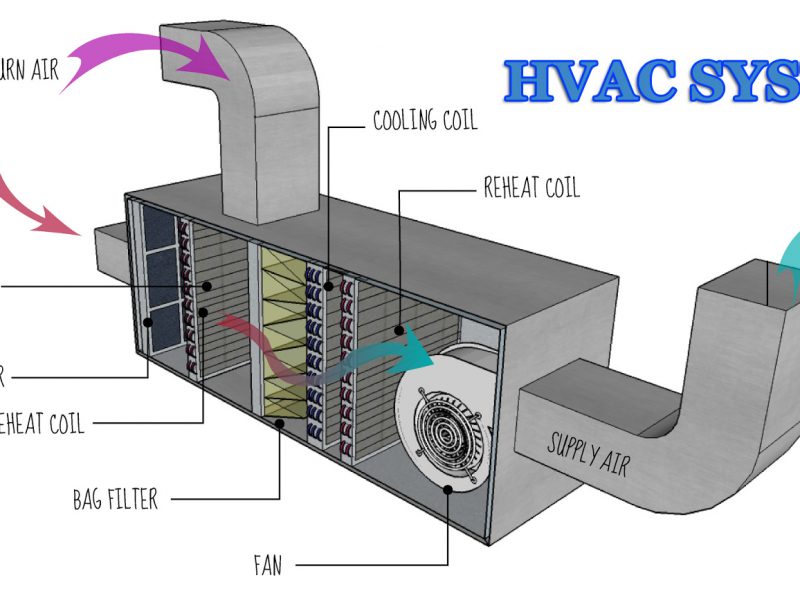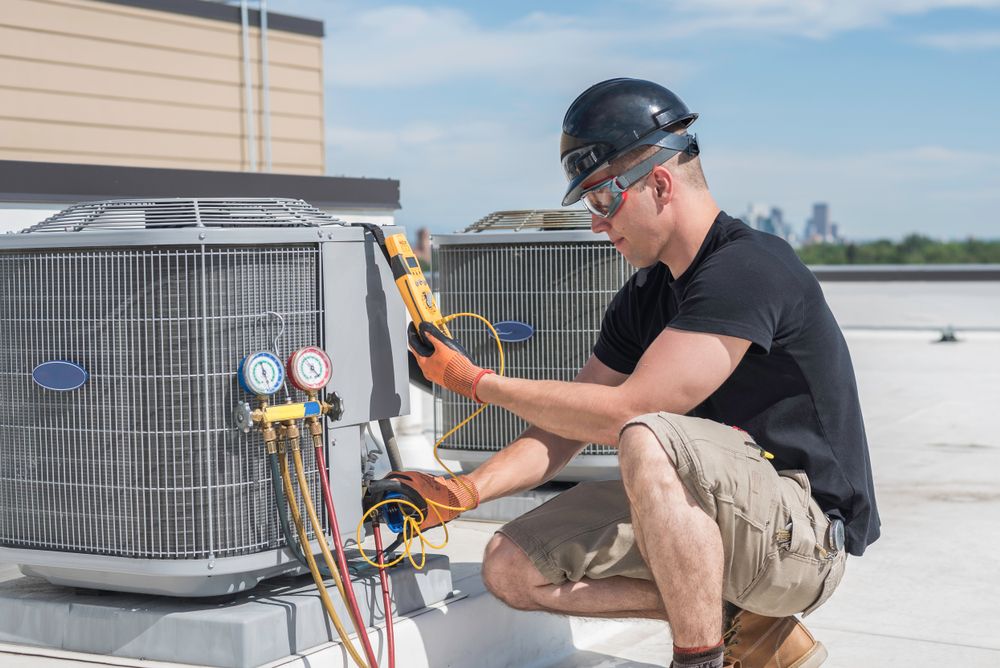Checking Out the Necessary Components of a Reliable Cooling And Heating System
An efficient cooling and heating system is improved a number of vital parts that work in consistency. Each part, from the thermostat to the ductwork, plays a crucial duty in maintaining comfort and power efficiency. Understanding these elements is vital for maximizing performance and improving interior air quality. As one examines these parts, the elaborate relationships in between them reveal insights into enhancing total system effectiveness. What particular aspects contribute most to this effectiveness?
The Function of the Thermostat in Heating And Cooling Efficiency

Usually forgotten, the thermostat plays a critical role in the efficiency of A/c systems. This tiny gadget serves as the key nerve center, regulating temperature settings and making certain optimal comfort within an area. By precisely noticing the ambient temperature level, the thermostat connects with the air, home heating, and ventilation conditioning devices to maintain the desired environment
A reliable thermostat lessens power intake by turning on the cooling and heating system just when necessary, consequently avoiding too much home heating or cooling. Modern programmable and wise thermostats boost this performance better by permitting customers to set schedules and remotely change setups, adapting to daily routines.
In addition, the placement of the thermostat is necessary; incorrect place can result in inaccurate temperature level readings, causing inefficient procedure. In general, a well-functioning thermostat not just enhances comfort yet likewise contributes markedly to energy cost savings and the long life of the a/c system.
Understanding the Value of Air Filters
Air filters offer a vital feature in HVAC systems by guaranteeing that the air flowing within a room continues to be healthy and tidy. These filters trap dirt, irritants, and various other toxins, stopping them from being recirculated throughout the environment. By capturing these bits, air filters add to improved interior air top quality, which can substantially profit residents' wellness, especially those with allergic reactions or breathing conditions.
In addition, keeping tidy air filters enhances the efficiency of cooling and heating systems. Clogged up filters can limit air flow, triggering the system to function more challenging to keep wanted temperature levels, leading to raised energy intake and greater utility bills. Consistently changing or cleaning up filters is an essential upkeep action that can extend the lifespan of HVAC tools. Inevitably, comprehending the relevance of air filters enables homeowners and structure supervisors to take proactive steps to assure a well-functioning, effective HVAC system that advertises a comfortable and secure interior atmosphere.

The Functionality of the Furnace and Warmth Pump
Furnaces and warmth pumps are essential components of cooling and heating systems, in charge of giving warmth throughout chillier months. Furnaces run by home heating air with burning or electrical resistance, then dispersing it throughout the home by means of air ducts. They normally provide quick home heating and can be fueled by gas, electrical power, or oil, depending upon the system type.
Alternatively, heat pumps move warm rather than produce it. They extract warm from the outside air or ground, also in low temperatures, and move it indoors. HVAC experts. This twin performance enables heatpump to likewise give air conditioning in warmer months, making them functional choices for year-round climate control
Both systems require appropriate upkeep to assure efficiency and long life. While furnaces succeed in extreme chilly, heatpump can be advantageous in modest climates. Understanding their distinct capabilities aids home owners in picking one of the most suitable choice for their home heating requires.
Exploring the Air Conditioning Device
The cooling device is a crucial part of a/c systems, available in various types to suit different requirements. Understanding the effectiveness scores of these units is vital for making notified selections regarding power intake and price. This area will certainly check out the varied kinds of ac unit and clarify how effectiveness ratings impact efficiency.
Kinds of Air Conditioners
While numerous aspects influence the choice of cooling systems, recognizing the various kinds offered is crucial for property owners and building managers alike. Central air conditioning conditioners are created to cool down whole homes or buildings, utilizing a network of ducts for air flow. Window units provide an even more local service, ideal for single spaces or small rooms. Mobile ac unit give adaptability, allowing users to relocate the unit as required. Ductless mini-split systems are an additional alternative, integrating the performance of central systems with the convenience of zoning, as they call for no ductwork. Finally, geothermal systems harness the planet's temperature for energy-efficient air conditioning. Each kind includes distinctive benefits, making educated options necessary for effective climate control.

Performance Rankings Clarified
Recognizing effectiveness rankings is necessary for selecting the right cooling unit, as these metrics give insight into the system's efficiency and power consumption. One of the most usual rating for ac unit is the Seasonal Energy Efficiency Proportion (SEER), which gauges the cooling result during a normal air conditioning season separated by the complete electric power input. A higher SEER suggests better performance. Furthermore, the Power Efficiency Ratio (EER) is used for determining efficiency under certain conditions. One more essential metric is the Energy Celebrity certification, which indicates that an unit satisfies rigorous power effectiveness guidelines. By assessing these ratings, customers can make informed choices that not only optimize convenience yet also decrease power prices and environmental effect.
The Value of Ductwork and Airflow
Efficient ductwork design and airflow administration play important functions in the overall effectiveness and efficiency of HVAC systems. Appropriate ductwork assurances that conditioned air is dispersed evenly throughout a room, reducing temperature level variations and enhancing convenience. Properly designed air ducts reduce resistance to air flow, reducing the work on cooling and heating devices and eventually decreasing energy usage.
Airflow management involves strategically putting vents and signs up to improve the flow of air. This avoids common issues such as hot or cold places, which can occur when air movement is obstructed or improperly balanced. Furthermore, the best duct products and insulation can further improve efficiency by minimizing warm loss or gain during air transit.
An effective ductwork system not just adds to power financial savings but can also extend the lifespan of a/c equipment by minimizing unneeded stress (HVAC experts). Consequently, comprehending the relevance of ductwork and airflow is essential for accomplishing peak HVAC system performance
Normal Upkeep Practices to Improve Efficiency
Routine upkeep techniques are essential for guaranteeing peak performance of cooling and heating systems. These methods include routine inspections, cleansing, and needed repairs to keep the system running effectively. On a regular basis transforming air filters is essential, as clogged filters can block air flow and lower efficiency. In enhancement, service technicians ought to inspect and tidy evaporator and condenser coils to stop getting too hot and energy wastage.
Yearly expert examinations are likewise recommended, as qualified specialists can identify possible issues before they rise. Oiling relocating parts minimizes wear and tear, contributing to a longer lifespan for the system. Guaranteeing that the thermostat functions correctly aids in preserving suitable temperature level control.
Often Asked Questions
Exactly how Typically Should I Replace My Thermostat?
Thermostats should generally be replaced every 5 to ten years, depending on usage and modern technology innovations. Regular checks are suggested to ensure peak efficiency, especially if experiencing inconsistent temperature control or raised power prices.
What Size Air Filter Is Best for My Heating And Cooling System?
The very best size air filter for a heating and cooling system differs by device style. Usually, it's vital to speak with the proprietor's guidebook or inspect the existing filter dimensions to assure peak efficiency and air top quality.
Can I Set Up a Heatpump Myself?
Mounting a warmth pump separately is possible for competent individuals, yet it requires understanding of electric systems and neighborhood codes. Working with an expert is suggested to assure appropriate setup and suitable system efficiency.
Just how Do I Know if My Ductwork Is Reliable?
To establish ductwork effectiveness, one need to look for leaks, measure air movement at vents, inspect insulation top quality, and examine temperature differences in between supply and return air ducts. Professional analyses can offer extensive understandings into overall performance.
What Are Signs My HVAC Requirements Immediate Upkeep?
Indicators that a cooling and heating system requires immediate maintenance consist of uncommon noises, irregular temperatures, raised energy expenses, undesirable smells, and frequent cycling. Addressing these problems immediately can protect against further damages and warranty height system efficiency.
Air filters serve an important more info feature in Heating and cooling systems by guaranteeing that the air circulating within a space continues to be healthy and tidy. Additionally, preserving tidy air filters boosts the efficiency of HVAC systems. Ductless mini-split systems are another option, integrating the efficiency of main systems with the ease of zoning, as they require no ductwork. Understanding efficiency rankings is crucial for picking the ideal air conditioning device, as these metrics supply insight into the system's performance and power intake. The best dimension air filter for a HVAC system varies by unit design.